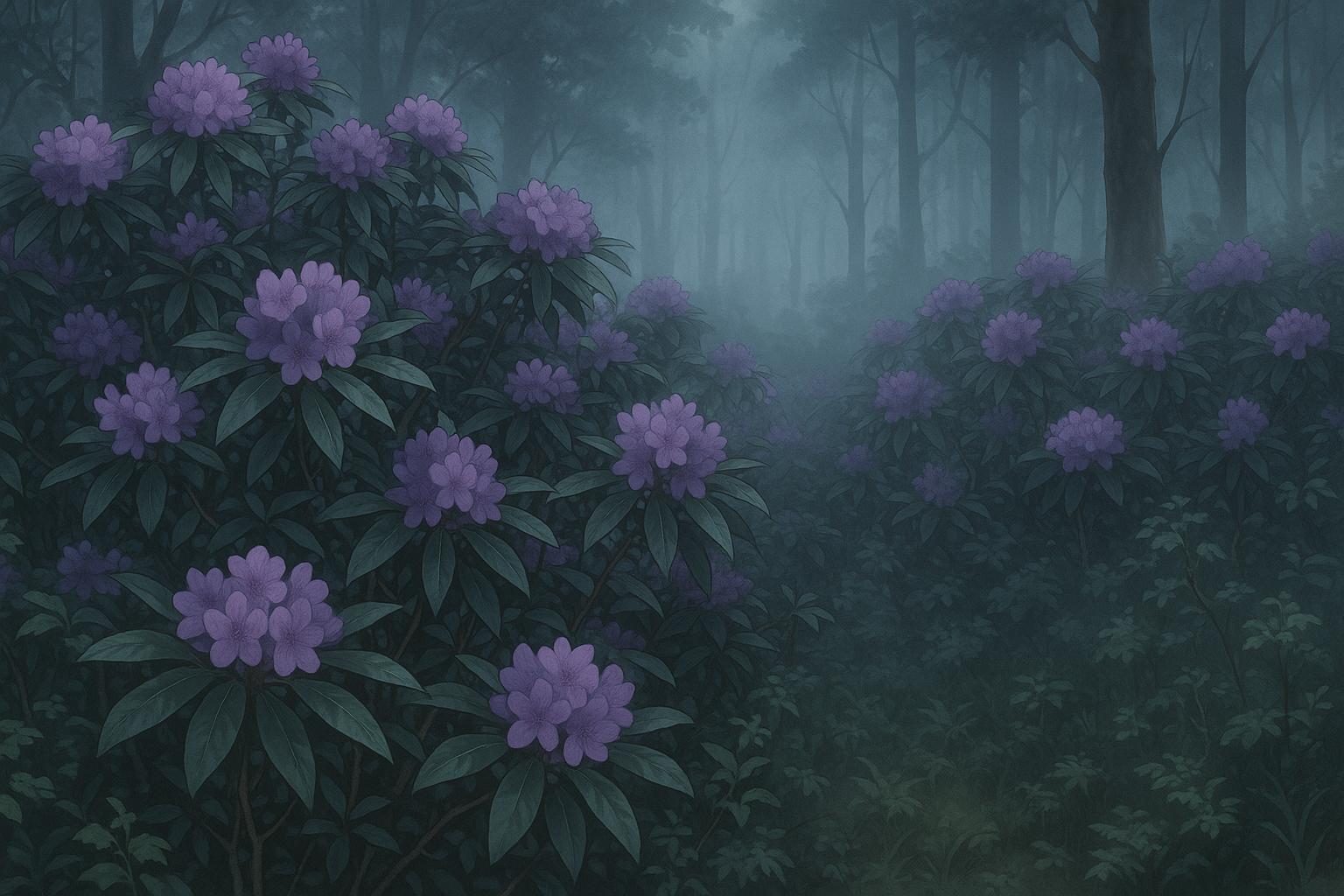While former TV presenter Timmy Mallett celebrates the vivid blooms of Rhododendron ponticum, experts warn that this invasive plant continues to devastate native Irish ecosystems, threatening biodiversity and raising significant ecological and economic challenges.
Despite its vibrant blooms, the invasive nature of Rhododendron ponticum casts a long shadow over the ecological landscapes of Ireland, particularly in the west. This plant, with its striking purple flowers, has become synonymous with landscapes that should otherwise be teeming with native flora. Introduced in the 18th century, Rhododendron ponticum has now established itself as one of the most pernicious invasive species on the island, spreading rapidly and forming dense thickets that choke native plants, disrupt local ecosystems, and present a serious challenge to biodiversity.
Timmy Mallett, the former children’s television presenter, recently celebrated the beauty of this plant during his cycling trip through Ireland. While his appreciation for the flora is understandable, it’s crucial to scrutinise the ecological ramifications of his endorsement. Rhododendron ponticum thrives in the country’s temperate climate, favouring acid soils and creating impenetrable barriers that prevent light from reaching the ground, leaving a biodiversity wasteland in its wake. Reports indicate that beneath the canopies of this invasive shrub, little else can grow. In contrast, Ireland’s native woodlands, which support a diverse range of species, are being smothered as the rhododendron continues its unchecked spread.
The implications of this invasive species extend beyond aesthetics. Not only does Rhododendron ponticum threaten the regeneration of native trees, but it is also toxic to livestock, producing grayanotoxins that pose dangers, particularly to sheep. Furthermore, the plant acts as a host for Phytophthora ramorum, a pathogen responsible for sudden oak death, thus compounding the risks to native European flora. The Woodland Trust has taken notice, with estate manager Dave Scott noting that without active management, woodlands dominated by invasive species like rhododendron will eventually collapse, leading to a loss of ecosystems that have endured for centuries.
Past efforts to manage Rhododendron ponticum have been extensive but face ongoing challenges. Since 2019, the Woodland Trust has managed the site at Mourne Park, successfully clearing 60 hectares of invasive plants using a combination of mechanical and manual removal methods. This project illustrates a growing trend in conservation: the need for multi-faceted approaches to restore ecosystems. In Killarney National Park, local initiatives also focus on collaboration with landowners to control the plant’s spread, recognising that grassroots efforts are vital in the fight against invasive species.
Recent statistics show that managing Rhododendron ponticum incurs significant costs; in Northern Ireland alone, the annual economic impact of controlling this invasive plant is approximately £270,000. This figure underscores the importance of awareness campaigns and calls for action, such as those associated with Invasive Non-Native Species Week, to galvanise public support against the sale and propagation of this destructive shrub.
While Timmy Mallett’s instinct to celebrate beauty in nature is commendable, it is vital for influencers and the public alike to understand the broader ecological consequences associated with seemingly benign plants like Rhododendron ponticum. If society is to preserve and enhance Ireland’s native landscapes, a collective commitment to managing invasive species and restoring biodiversity is essential. The responsibility to say “no” to rhododendrons must extend beyond the garden—it’s a call to action for all who cherish the natural heritage of Ireland.
Reference Map:
- Paragraph 1 – [1], [2], [3]
- Paragraph 2 – [2], [3], [4]
- Paragraph 3 – [5], [6], [7]
- Paragraph 4 – [1], [4], [7]
- Paragraph 5 – [3], [6]
Source: Noah Wire Services
- https://www.irishnews.com/life/just-say-no-to-rhododendron-casual-gardener-OPFIXS27HFGTBBAFLB7KPH2D3E/ – Please view link – unable to able to access data
- https://www.knotweed.ie/the-plants/rhododendron/ – Rhododendron ponticum, native to regions including Turkey, Lebanon, Bulgaria, the Caucasus, Spain, and Portugal, was introduced to Ireland in 1763 for ornamental purposes. It has since become highly invasive, particularly in western counties and upland areas. The plant thrives in acid soils, forming dense thickets that outcompete native flora, hinder tree regeneration, and disrupt local ecosystems. Additionally, it is toxic to livestock and can host disease organisms harmful to oak and beech trees.
- https://www.jkienvironmental.ie/plant-species/rhododendron – Rhododendron ponticum, introduced to Ireland in the 18th century, has become a significant invasive species, especially in the west. It is known for its large purple flowers and evergreen leaves. The plant reproduces both sexually and asexually, producing up to one million seeds annually. Its dense growth outcompetes native species, forms impenetrable thickets, and is toxic to livestock. Moreover, it serves as a host for the pathogen Phytophthora ramorum, which causes sudden oak death.
- https://www.nationalparks.ie/wild-nephin/invasive-species-week-15th-21st-may-2023/ – Rhododendron ponticum, introduced to Ireland in the 19th century, has become naturalised and thrives in the country’s temperate climate. It establishes on well-drained, acid soils, invading woodlands, forestry plantations, and peatlands. Mature plants form dense thickets, replacing native shrub layers and ground flora, preventing natural tree regeneration, and causing habitat loss. Additionally, rhododendron is unpalatable to herbivores and hosts Phytophthora pathogens that can spread and kill tree species.
- https://fermanagh.bsbi.org/rhododendron-ponticum-l – In Fermanagh, Rhododendron ponticum has been recorded in 74 tetrads, primarily around Upper and Lower Lough Erne. It often forms dense evergreen thickets 3 to 5 meters tall, especially in old estate woods and upland peaty areas. The plant is toxic, containing grayanotoxins that can poison livestock, particularly sheep. Its roots release allelopathic chemicals, deterring other plants, and it forms mycorrhizal associations, potentially starving competing plants in nutrient-poor acidic soils.
- https://kerrybiosphere.ie/news/71-mapping-rhododendron-with-citizen-science – Rhododendron ponticum, introduced in the 19th century, has spread extensively in Kerry, particularly in Killarney National Park and the MacGillycuddy Reeks. It forms dense thickets that shade out native vegetation and prevent regeneration. The National Parks and Wildlife Service has been managing rhododendron in Killarney National Park for years. The MacGillycuddy Reeks European Innovation Partnership Project collaborates with local landowners to control rhododendron and prevent habitat loss in protected heath and bog areas.
- https://www.bbc.com/news/uk-northern-ireland-27946780 – Rhododendron ponticum, native to Europe and Asia, was introduced to Ireland in the 1700s as an ornamental shrub. It has become one of the most invasive species on the island, forming dense thickets that outcompete native plants. The plant’s dense roots and toxic leaves hinder the growth of other vegetation. In Northern Ireland, it costs approximately £270,000 annually to control and remove rhododendron, highlighting its significant economic impact.













